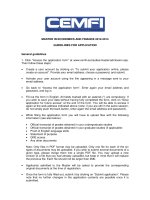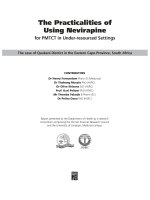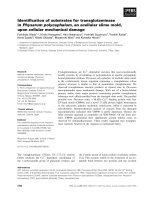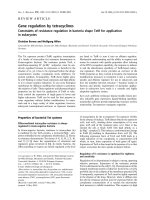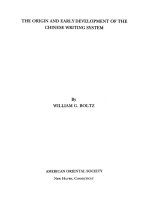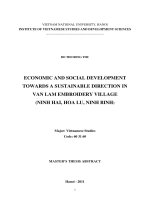nvestigating the influences of tidal inundation and surface elevation on the establishment and early development of mangroves for application in understanding mangrove rehabilitation techniques 1 2
Bạn đang xem bản rút gọn của tài liệu. Xem và tải ngay bản đầy đủ của tài liệu tại đây (153.33 KB, 7 trang )
1
Chapter 1 – Introduction
1.1 Mangroves are highly threatened
Mangroves provide a suite of highly valued ecosystem services (Barbier, 2007;
Rönnbäck et al., 2007), which can be classified into supporting (Walters et al., 2008),
provisioning (Rönnbäck, 1999; López-Hoffman et al., 2006; Rönnbäck et al., 2007),
regulating (Gilman & Ellison, 2007; Bosire et al., 2008; Gilman et al., 2008;
Kristensen et al., 2008; Donato et al., 2011; Rivera-Monroy et al., 2013) and cultural
services (Millennium Ecosystem Assessment, 2005; Rist & Dahdouh-Guebas, 2006;
Walters et al., 2008). Despite providing a wide range of ecological and socio-
economic benefits, mangrove ecosystems are generally over-exploited, undervalued,
and poorly managed, with only 6.9 % of total mangrove area protected under the
existing protected areas network (IUCN protected areas categories I – VI) (Giri et al.,
2011). Human exploitation and conversion of natural ecosystems is causing
widespread ecosystem loss and degradation, with estimates of global mangrove losses
ranging from 33 % (Alongi, 2002) to 50 % (Burke et al., 2001). Mangroves are
additionally vulnerable to climate change such as rising sea levels that expose
mangroves to longer and more frequent inundations which may surpass their natural
inundation thresholds, resulting in the die-back of mangroves (Nicholls et al., 1999;
Nicholls & Cazenave 2010).
The drivers of mangrove degradation are diverse. They include deforestation
(Macintosh et al., 2002; Gilman & Ellison, 2007), urban development (Ellison &
Farnsworth, 1997; Lai et al., 2015), agriculture (Chen et al., 2007; Chen et al., 2009;
Webb et al., 2014), commercial aquaculture (Hossain et al., 2001; Barbier & Cox,
2002; Barbier, 2006) and modification of hydrology (Kairo et al., 2001; Ren et al.,
2
2009). Of these, development-related activities such as urbanisation, aquaculture and
deforestation have been identified as the top three activities contributing to most of
mangrove degradation (Dale et al., 2014). In Asia, deforestation and aquaculture
activities were responsible for huge expanses of derelict land. For example, Philippines
lost 67% of their mangroves between 1951 and 1987, of which conversion of
mangroves to aquaculture ponds accounted for approximately half of the loss
(Primavera, 1993). Additionally, the lifespan of most intensive shrimp ponds are
restricted to 5 – 10 years and end up abandoned due to self-pollution and disease
problems (Flaherty & Karnjanakesorn, 1995; Stevenson, 1997).
1.2 Past attempts at mangrove rehabilitation
Mangroves have the potential to recover from degradation to produce self-sustaining
ecosystems resilient to normal periodic stresses (Borja et al., 2010). Through
secondary succession, degraded ecosystems can be rehabilitated to the pre-existing
functional condition. Mangrove rehabilitation may: (i) occur naturally through
secondary succession with no human intervention; or (ii) be engineered through
human-aided secondary succession (SER, 2004; Elliott et al., 2007; Simenstad et al.,
2006; Stein & Cadien, 2009). As some mangroves have been degraded to the extent
where natural recovery is no longer possible, there is an increasing need to catalyse the
recovery of mangroves through human-mediated mangrove rehabilitation projects
(Kaly & Jones, 1998).
1.2.1 Defining mangrove rehabilitation
In scientific literature, the terms “restoration” and “rehabilitation” of mangrove
ecosystems have frequently been used interchangeably. Some papers adopt broad
definitions (i.e. Macintosh et al., 2002; Biswas et al., 2009; Kamali & Hashim, 2011;
3
Ye et al., 2013) whereas others adopt narrower definitions where restoration is
reported but the term rehabilitation is not mentioned (i.e. Hoang Tri et al., 1998; Chen
et al., 2009; Ren et al., 2011; Chen et al., 2012; Rovai et al., 2012).
Primarily, this study will use “rehabilitation”, defined as the act of partially or fully
replacing the structural or functional characteristics of an ecosystem that have been
diminished or lost, or the substitution of alternative qualities or characteristics than
those originally present such that they have more social, economic or ecological value
than existed in the disturbed or degraded state (Field, 1999; Ellison, 2000; Chen et al.,
2007). The term “functional” refers to ability of rehabilitated mangroves to stabilise
shorelines, trap sediments, improve coastal protection, offer suitable animal habitat,
provide timber, and heighten the aesthetic value of coastal areas, in a way comparable
to natural mangroves (Bosire et al., 2008). Any inevitable use of the term “restoration”
would also point to “rehabilitation” as it is almost impossible to “restore” and return
any ecosystem back to its original condition (Field, 1999).
1.2.2 A lack of mangrove rehabilitation success
The lack of rehabilitation success has been widely reported (Field, 1999; Elster, 2000;
Bosire et al., 2008; Primavera & Esteban, 2008) and attributed to the lack of
knowledge and experience. For instance, most rehabilitation efforts in Southeast Asia
have followed a trial and error method without any explicit framework, baseline
ecological information, or proper consideration of community involvement (Biswas et
al., 2007; Biswas et al., 2009). Some efforts meet with immediate failures while others
fail several years after initiation (Ellison, 2000), with costs of a failed rehabilitation
attempt ranging from a few thousand to millions of dollars. For instance, the outcome
of two decades of immense mangrove rehabilitation efforts in Philippines has cost
4
millions of dollars, with only 10 – 20% long-term survival rates (Primavera & Esteban,
2008).
Topography governs mangrove distribution, with physical processes playing a
dominant role in their formation and function (Kjerfve, 1990). Hence, knowledge of
appropriate surface elevations, and its inherent control on inundation periods, are
arguably the critical determinants of mangrove rehabilitation success (Stevenson et al.,
1999; Lewis, 2005; Lewis, 2009; Gilman & Ellison, 2007; Friess et al., 2012). The
relationship between surface elevation/inundation regime and mangrove establishment
and physiological development has been studied widely, with the consensus that
mangroves exhibit species-specific thresholds to inundation periods, and hence surface
elevations (McKee, 1995; Kitaya et al., 2002; Chen et al., 2005; He et al., 2007; Chen
et al., 2013).
Yet, rehabilitation attempts commonly move immediately into manual planting of
mangrove propagules and/or seedlings (Salmo et al., 2007) without first rehabilitating
the physical environment (i.e. surface elevation) and processes that govern the
distribution and maintenance of mangroves (Lewis, 2005; Primavera & Esteban, 2008;
Samson & Rollon, 2008; Friess et al., 2012). Some projects further avoid dealing with
long-drawn land tenure issues in areas where mangroves naturally establish by
“rehabilitating” natural mudflats (Moberg & Rönnbäck, 2003). Species selection in
particular, has failed to consider the biological inundation thresholds of planted
species. This is most clearly seen in rehabilitation projects that often support the
planting of commercially attractive but non-pioneer species such as Rhizophora
species on low-elevation mudflats (i.e. the pioneer zone) where mangroves did not
previously exist because of natural environmental constraints (Lewis, 2005; Samson &
Rollin, 2008). A more appropriate species would be Avicennia species, which has been
5
shown to be the most widespread genus of mangrove pioneer trees that colonise bare
tidal flats of tropical regions around the world (A. marina in Africa – Osborne &
Perjak, 1997; A. alba for Southeast Asia – Lee et al., 1996; Panapitukkul et al., 1998;
A. germinans in South America – Proisy et al., 2009; Allemen et al., 2011; A. marina
in Australia – Clarke, 1993).
1.3 Ecological Mangrove Rehabilitation (EMR)
EMR is a rehabilitation approach that seeks to produce functional and self-sustaining
ecosystems through the removal of barriers and/or stressors that impede natural
recovery. The approach advocates identifying site-specific causes of ecosystem
degradation before manipulating the structural and compositional components of the
physical environment to optimise it for sustainable regeneration via natural recruitment
and establishment (Lewis, 2005). Structural manipulation encompasses hydrological
(i.e. re-establishing a suitable tidal regime) and substrate engineering (to achieve
suitable elevation ranges). This are essential components which offer reference for
planning mangrove rehabilitation as mangroves generally do not establish below mean
sea level (Stanley & Lewis, 2011) and generally exhibit species-specific tolerances to
abiotic conditions such as inundation period and salinity. Compositional manipulation
includes seeding and/or planting multiple species (Biswas et al., 2009). However, any
planting should only be used as a last resort. The approach also advocates periodic
post-rehabilitation monitoring and the inclusion of multiple stakeholders in order to
achieve rehabilitation success and long-term management of a rehabilitated site.
1.4 Aims and objectives
The aim of this thesis is to contribute to the understanding of hydrologic management
in the success of mangrove rehabilitation projects. The focus is on how surface
6
elevation and tidal inundation influences the establishment, survival and early
development of mangroves. The broad question is examined through a large scale field
study and further through a controlled mesocosm experiment. Specifically, the field
study examines the influence of surface elevations on mangrove establishment and
early development while the mesocosm experiment was designed to provide
complementary knowledge through examining the influence of inundation durations
on mangrove development and survival. Additionally, the mesocosm experiment also
functioned to control for confounding factors in the field study that may affect
observed field results. In this thesis, there are two specific objectives to be achieved:
1. Investigate how hydrologic restoration contributes to the successful establishment of
mangrove vegetation in rehabilitated sites.
In this study, the effects of two aspects of hydrologic restoration on mangrove
rehabilitation were studied. The study site was located in Makassar, Sulawesi,
Indonesia and comprises of abandoned aquaculture ponds that were formerly
forested with mangroves. The study focused on (i) tidal inundation regime – by
restoring a gradient of tidal regime in the abandoned ponds to study the effects
of inundation and (ii) surface elevation – regrading the site to study the effects
of differing surface elevations relative to sea level. The above two were carried
out via strategic breaching of dike walls and regrading of selective areas to
produce substrate at appropriate surface elevations for mangroves, relative to
sea level. Quantification of rehabilitation success was achieved via vegetation
surveys which mapped and quantified the extent of recolonisation of mangrove
vegetation.
7
2. Quantify the inundation thresholds impacting survival and growth for two selected
mangrove species – Rhizophora mucronata and Avicennia alba.
There exist inter-specific variations on the thresholds of mangroves to
inundation durations. Yet, this frequently goes unacknowledged given that
inappropriate species are planted under sub-optimal conditions. Rhizophora
propagules are favoured for planting in “rehabilitation projects” on low
elevation mudflats, when a more appropriate choice would be the pioneer
genus, Avicennia. As such, a controlled experiment was used in this study to
test the effect of inundation (i.e. inundation threshold) on seedling survival and
growth of these two species – R. mucronata and A. alba. The experimental
design used a mesocosm set-up that exposed seedlings to increasing inundation
durations. The objective was to observe if mangrove species exhibited natural
inundation thresholds which when exceeded, had negative effects on survival
and growth rates of seedlings.

